What Hi-Fi? Verdict
The dimming-zone rich QN95C proves emphatically that Mini LED is much more than just a bright room technology
Pros
- +
Dazzlingly bright HDR pictures
- +
Peerless LCD TV black levels
- +
Excellent gaming support
Cons
- -
No Dolby Vision support
- -
Some out-of-the-box backlight flaws
- -
Default motion settings are poor
Why you can trust What Hi-Fi?
On the surface, at least, the traditional divisions between different TV technologies appear to be breaking down. In 2023 we’ve got OLED screens turning to new technologies to deliver levels of brightness alongside their traditional black-level prowess that we never thought OLED would be capable of, while in the LCD world we’ve got Mini LED TVs combining their tiny light sources with much more advanced local dimming to introduce better black level performance to go with their traditional brightness advantage.
Fun though this picture quality convergence sounds in principle, though, the reality as represented here by Samsung’s new flagship 4K Mini LED TV, the QN95C, suggests that not only is there actually still plenty of TV tech divergence out there, but that such divergence is actually something to celebrate.
Price
At £3699, the Samsung QE65QN95C is positioned as a (very) premium TV. In fact, in a telling example of just how much faith Samsung has in its Mini LED technology, the QE65QN95C is actually slightly (£100) more expensive than the brand’s new top-end QD-OLED TV, the S95C. That’s despite the fact that, unlike its predecessors, the QN95C ships without an external One Connect connections box.
The 65-inch QN95C is joined by £2799 55-inch, £4999 75-inch and £6999 85-inch siblings. Note that aspects of the screen specification, most notably the exact number of local dimming zones they use, will vary between screen sizes.
At the time of writing, the QN95C is not listed as being available in Australia, where the most premium Samsung 4K TV available for 2023 looks set to be the slightly less well-specified, less extravagantly designed QN90C.
Design
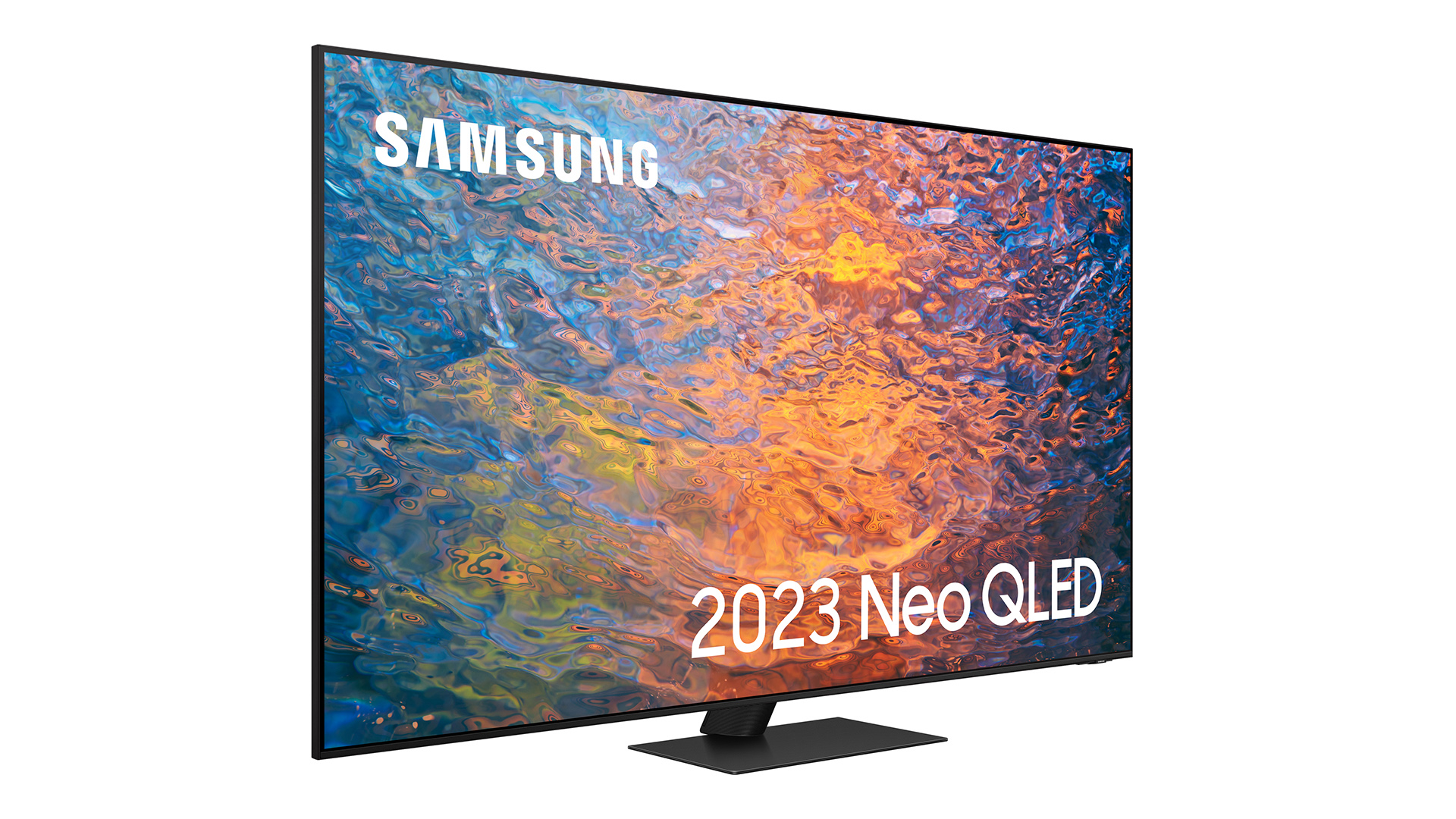
The Samsung QN95C diverges quite significantly from its 2022 predecessor, partly through its ditching of the One Connect box, but also by adopting the so-called Infinity One design previously associated exclusively with Samsung’s 8K TVs. This means it sports an ultra-thin frame around the screen, which gives way round the back to a slender (by direct-lit LCD standards, anyway) rear that’s pretty much as flat as the front. Add a tasteful corrugated finish to this rear and a metallic look to the TV’s slender sides and you’ve got a handsome attempt to deliver a true 360-degree design.
The QN95C’s design lends itself nicely to hanging on a wall – though the supplied heavy-duty metal plate desktop stand looks very tidy too. The stand also includes a series of grooves down its back to help you hide cables, making the loss of the external One Connect easier to bear.
The screen is accompanied by two remote controls: a regular button-loaded one and a sleeker, smaller ‘smart’ one that Samsung clearly expects most people to use the most. Both are rather plasticky and lightweight for handsets supplied with a flagship TV, but they’re also both very easy to use and the smart one also brilliantly supports recharging via either the solar panel on its rear or your router’s wi-fi signals. Some day, we suspect (and hope), all remotes will go battery-free in this way.
Features
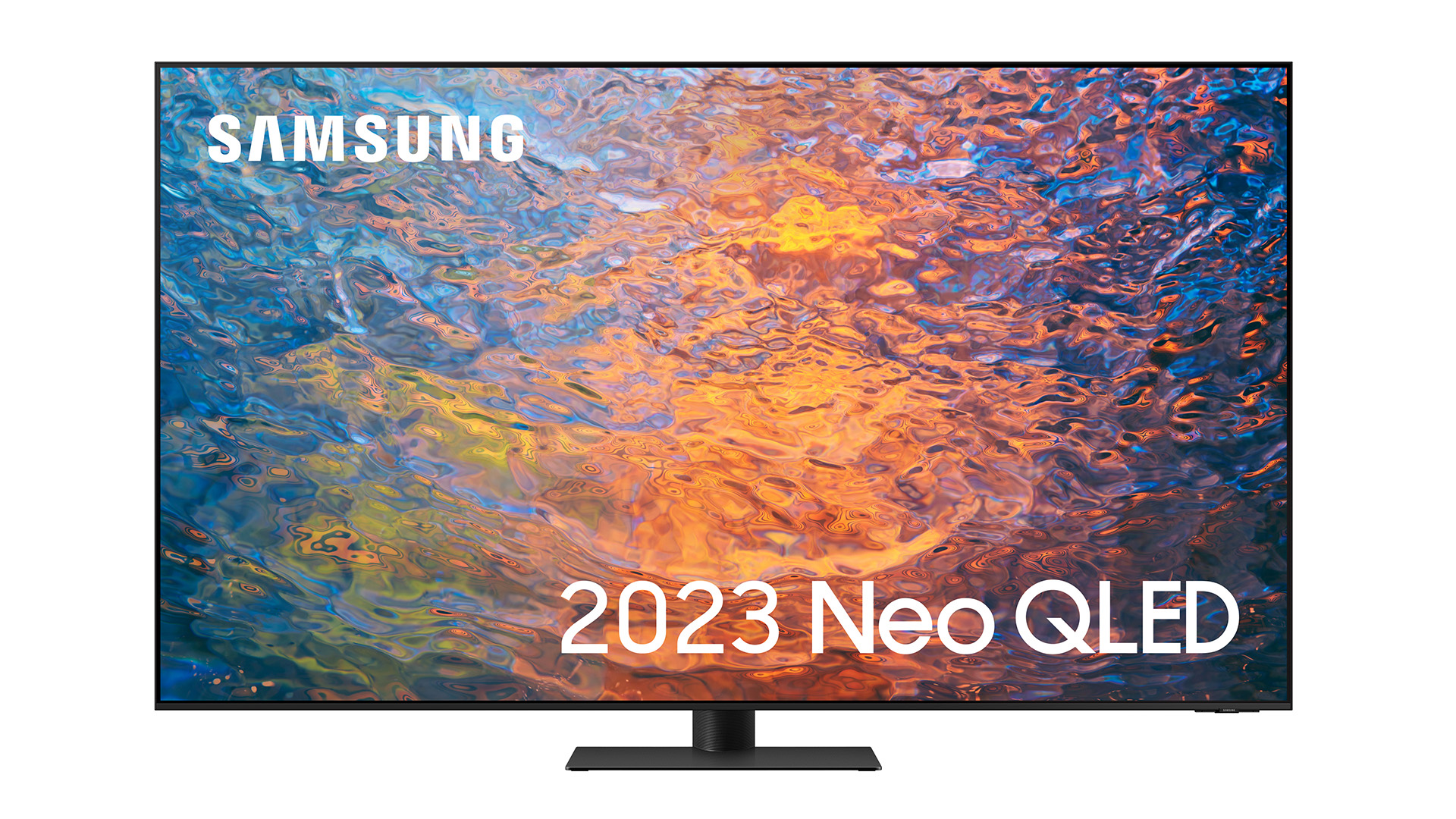
The main attraction of the Samsung QN95C is undoubtedly the uncompromising design of its screen. Starting with the fact that it uses Mini LED technology, where a huge number of much smaller LEDs than those found in normal LED TVs have been fitted directly behind the screen to contribute to both more potential brightness and, more importantly, finer control of where light goes in the finished picture.
The QN95C’s predecessor also used Mini LED technology, though. So more interesting to anyone looking for an improvement for the 2023 model will be the fact that the 65-inch model enjoys 1344 zones of local light dimming versus its predecessor’s 720. That’s an increase of nearly 90 per cent in a single generation. And given how generally impressive Samsung has tended to be with its management of much lower dimming zone counts, hopes have to be very high indeed for a 1344-zone model.
The panel inside the QN95C is a VA one rather than a contrast-challenged IPS one, and the panel is also designed to both suppress reflections and support far wider viewing angles than regular LCD panels. Aims that it succeeds in superbly well. Driving the new dimming zone array – and everything else associated with the QN95C’s picture, sound and smart functionality – is a new Neural Quantum processor. Perhaps worryingly for Terminator fans, this now draws on the picture experience gained by no less than 20 separate neural networks when identifying and figuring out how best to respond to different types of picture source.
The extra shortcuts to better pictures provided by the latest Neural Quantum processor’s ‘experience’ are given added importance because as well as providing so many more dimming zones to manage, the QN95C also introduces a significant new Real Depth Enhancer Pro feature that attempts to micromanage multiple facets of a picture to create more holistic, object-based images that are more in keeping with the way your eyes tend to take in the real world.
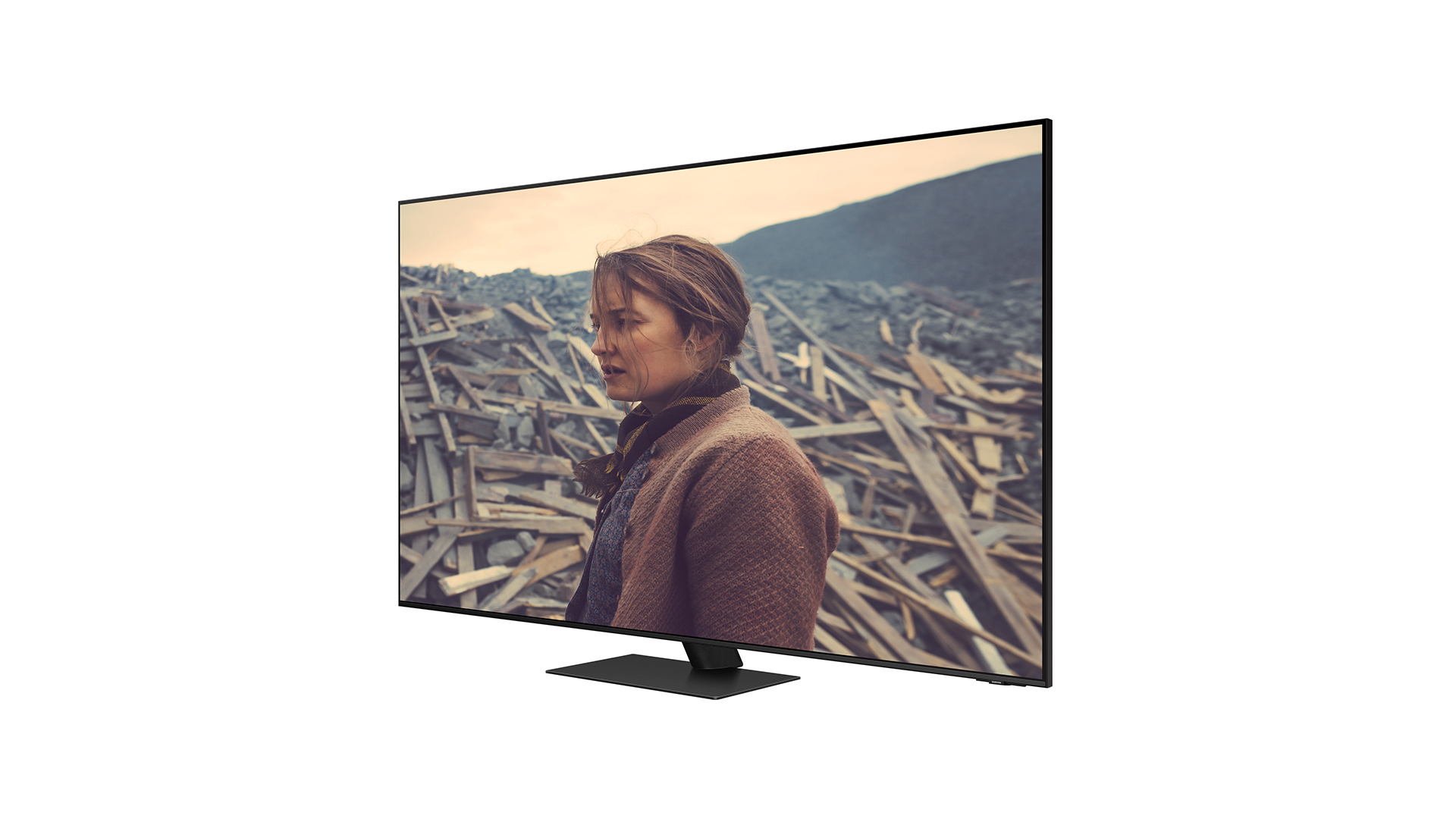
Screen size 65 inches (also available in 55in, 75in and 85in)
Type QLED
Backlight Mini LED
Resolution 4K
HDR formats supported HLG, HDR10, HDR10+
Operating system Tizen
HDMI inputs 4 (4 x 48Gbps HDMI 2.1)
Gaming features 4K/120, VRR, ALLM, HGiG
ARC/eARC eARC
Optical output? Yes
Dimensions (hwd, without stand) 83 x 144 x 2.1cm
The new processor is also reckoned to bolster Samsung’s already pretty dependable upscaling of HD to 4K, and is adaptable enough to keep input lag (the time the screen takes to render image data) down to just 9.8ms when the TV is in its Game mode.
Now we’re on the subject of gaming, all four of the QN95C’s HDMIs support the latest gaming features of 4K/120Hz, VRR (including AMD Freesync Premium Pro), and ALLM.
A dedicated Game Bar menu screen gives you fast access to a few other gaming-specific features, too. You can, for instance, trade a little response speed for enhanced visuals if you’re playing something like an RPG that isn’t dependent on super-fast reaction times.
You can also raise the brightness floor of dark parts of a game’s graphics to make it easier to see hidden enemies or traps; you can magnify and even share a game’s minimap if it has one; and you can call up a virtual aiming point in the centre of the screen.
The four high-bandwidth HDMIs naturally have no trouble also handling 4K/24p movie feeds in the HDR10, HLG and HDR10+ HDR formats. The only frustration, as ever with Samsung, is that the HDR support doesn’t extend to Dolby Vision, even though there continues to be substantially more Dolby Vision sources out there than there are HDR10+ ones.
Samsung has thankfully refined its smart system from the rather unhelpful overhaul it introduced in 2022. The ‘shelves’ on the home page are now more likely to contain content you’re actually interested in, and the scrollable home page has been simplified without, it seems to us, losing anything of particularly great importance. Some aspects of the menu navigation system could clearly do with being slicker and quicker to follow, though.
The Gaming Hub section has become increasingly useful this year, meanwhile, as a home for both connected and streaming game sources.
Accompanying the QN95C’s Mini LED-driven imagery is a promising 70W sound system capable of delivering Dolby Atmos soundtracks through a 4.2.2 channel count. There’s continued support, too, for Samsung’s typically impressive Object Tracking Sound system, where the placement of speakers all around the TV’s bodywork helps to generate a sense of a busier, larger soundstage into which specific effects are placed with extra accuracy.
The QN95C can ship (lossy) Dolby Atmos sound wirelessly to compatible Samsung soundbars, as well as using Samsung’s Q-Symphony feature to potentially add its speakers to those of a Samsung soundbar to deliver a bigger, more detailed sound mix.
Serious cinephiles likely to consider getting their QN95C professionally calibrated might want to note that the set supports the premium version of Samsung’s Smart Calibration system, where the TV can essentially calibrate itself to a near-professional standard using nothing more than a recent smartphone.
Probably the quirkiest feature of the QN95C, finally, is the slimline detachable camera the TV ships with. This introduces the potential for gesture control as well as video calling – but we didn’t feel very inclined to attach the camera to enjoy either of these dubious benefits, honestly.
Picture
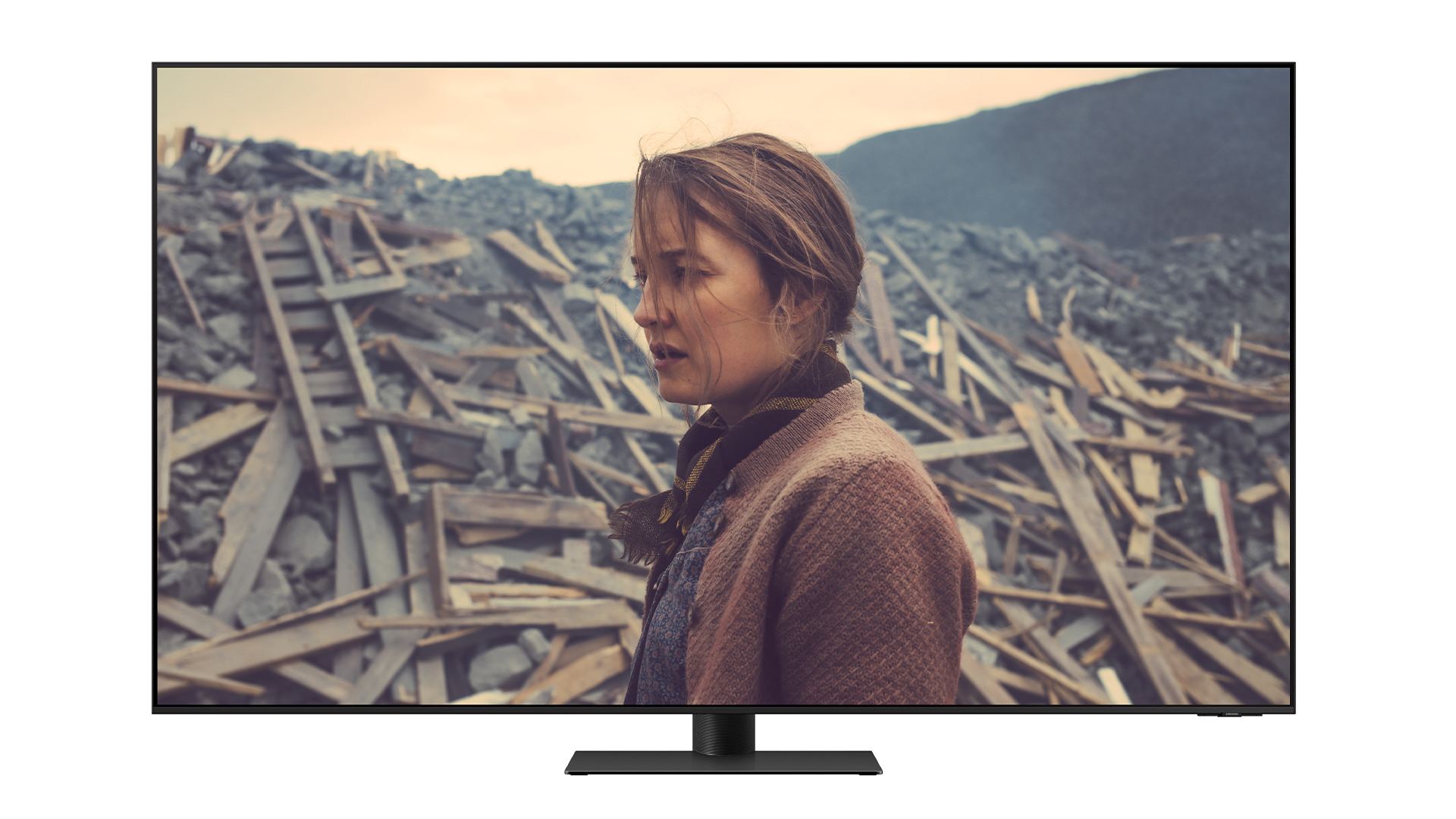
It’s obvious pretty much instantly that nearly doubling the QN95C’s dimming zone count has had a profoundly positive effect on its picture quality.
The most obvious result is that halos of extraneous light are even less likely to appear around bright highlights – even if those highlights are appearing against an essentially black backdrop – than they were on the QN95B. The latter being a TV which itself kept blooming more subdued than it was on arguably any other FALD (Full Array with Local Dimming) TV out there.
Haloing barely becomes more noticeable when viewing the TV from quite wide horizontal angles this year, either. It’s only if you look at the screen from a fairly sharp vertical angle that haloing suddenly becomes distractingly apparent.
Anyone who has read our other reviews of Samsung FALD TVs in recent years will know that the brand’s mostly admirable obsession with preventing halos of unwanted light infiltrating dark scenes can require some relatively small stand-out bright objects in a picture to be dimmed down. Happily, though, the substantial increase in dimming zones reduces both the frequency and the extent to which this aggressive dimming effect makes its presence felt in the picture.
That isn’t to say, though, that the issue has completely gone away; Samsung’s hatred of haloing still means that even smaller light halos cannot be tolerated, meaning small bright picture highlights can still take a brightness hit that denies them the sort of intensity and local contrast dynamism they would enjoy on a self-emissive OLED screen. It’s still a big relief to find this issue appearing less commonly than it did on 2022’s equivalent model, though.
The QN95C’s new-found light accuracy helps it achieve even more consistently deep black levels than those of last year’s QN95B – a TV that was itself arguably the best LCD TV around for showing dark scenes with minimal interference from backlight greyness or clouding issues. The 2023 model handles fades to black with essentially OLED levels of pure blackness – and it does so, moreover, without any of the obvious flashing on and off of the backlight array that you sometimes see with FALD TVs when they try to do ‘full black’.
Black levels remain profound during shots with a mix of light and dark content too, at least in the Standard and Filmmaker Mode presets. We’re talking about the deepest – or certainly the most consistently deep – black levels in the LCD TV world, basically.
The Movie preset strangely introduces a marginally green undertone to dark scenes that can actually bring out a little too much shadow detail in the darkest areas. Though in doing so, it reveals that the Standard and even, to a lesser extent, the Filmmaker modes can suffer with some black crushing effects (lost detailing in dark areas) in their default settings.
The Standard picture preset that many users will feel drawn to for most of their TV viewing thanks to its extreme brightness, rich contrast and bold colour presentation also suffers in its default mode from some rather obvious backlight brightness shifting if you’re watching an HDR scene that features abrupt cuts between bright and dark shots. The fact that there’s a momentary delay in the dimming effect following a bright to dark cut makes the aggressiveness of this feature – which is presumably applied, again, to suppress blooming artefacts – more noticeable too.
Fortunately, the precise sort of content that causes this dimming/brightening effect is pretty rare, and you can actually stop it happening if you turn off the Standard preset's Contrast Enhancer function. Doing this inevitably reduces the picture’s luxurious dynamism a bit, but the trade-off in immersive consistency – especially if you’re about to watch an HDR presentation of a film that contains a lot of dark scenes – is worth it. And the picture still looks seriously spectacular by any normal TV standards.
This bright-to-dark cut issue does not affect the QN95C’s Movie or Filmmaker Mode presets, by the way, so home cinema purists probably won’t even have to worry about making the relatively small effort to fix the problem if they’ve chosen a relatively accurate picture preset. Though it’s worth noting that the TV lacks a fair bit of colour vibrancy in these presets when compared with the Filmmaker Mode delivery of many rival sets. The long and the short of it is that none of the QN95C’s presets is ideal out of the box, and Samsung should consider offering one that sits somewhere between Movie and Standard.
Getting back to the good news, as well as managing to achieve class-leadingly bloom-free LCD black colours, the QN95C can also get ferociously bright. In all presets it’s capable of punching out the brightest highlights of the picture with a level of intensity substantially beyond anything even the new generations of OLED TV technology will be able to match. This is especially noticeable where there’s a very bright peak within an already bright image, as there’s no need to limit the highlight’s intensity for fear of causing unwanted haloing.
With image content where the QN95C does have to dim down small light highlights to combat the dreaded haloing issue, new OLED TVs such as the LG G3, with their self-emissive pixels, still achieve more intensity for the bright highlights than the QN95C does. The QN95C reasserts its brightness authority emphatically, though, with HDR images that are pretty uniformly bright, driving such ‘full-screen brightness’ content out in all presets (but especially Standard and Dynamic) with two to three times as much pure brightness as even the best new OLEDs will likely muster.
This facet of the QN95C’s performance reaffirms that however much OLED screens might be trying to muscle in on LCD turf and vice versa this year, if you’re a fan of really bright HDR pictures and/or you have a bright room to work with, premium LCD still has some unique things going for it.
The sharpness and purity of the QN95C’s images keeps the good news coming. This is pretty typical of Samsung TVs, in truth, but the latest processing engine helps the sharpness feel more natural and organic than it has tended to before. Source noise is better handled as well (especially when the TV is upscaling an HD source), and any sharpness enhancement that may be applied by default to some of the picture presets does its work while generating remarkably few unwanted side effects.
The only processing area that lets the QN95C down is its default motion handling. The Auto setting for the Picture Clarity system creates too many unwanted processing distractions/glitches and smoothes 24p films so much that they start to look like soap operas. Turning Picture Clarity and its multiple sub-settings off improves things, but this can lead to judder coming on a bit too strong with horizontal pans. Fortunately, a very workable solution is achievable by selecting the Custom Picture Clarity setting and then adjusting the judder and blur motion control elements to somewhere around their level two or three settings.
While the QN95C is really literally made for HDR, it actually does a brilliant job with standard dynamic range sources too. The Standard mode presents SDR with almost HDR levels of brightness and punch without typically making the picture look strained or unnatural, while the Movie and Filmmaker Modes deliver SDR out of the box in its much dimmer, much more authentic state if that’s your preference.
Last but very much not least on the QN95C’s long list of achievements is its gaming performance. It looks nothing short of sensational at all times, handling 120Hz beautifully, taking the most variable of variable refresh rates in its stride, and best of all delivering graphics from the latest consoles and PCs with a combination of brightness, contrast, colour saturation and sharpness that almost makes you feel as if you’re playing trusty old favourites for the very first time.
The only thing missing from the QN95C’s gaming arsenal is support for Dolby Vision gaming. But with HGIG and HDR10+ both on hand to help get the most from today’s HDR gaming world, it remains hard to think of another TV, even one that supports Dolby Vision, which delivers a more spectacular gaming experience.
Sound
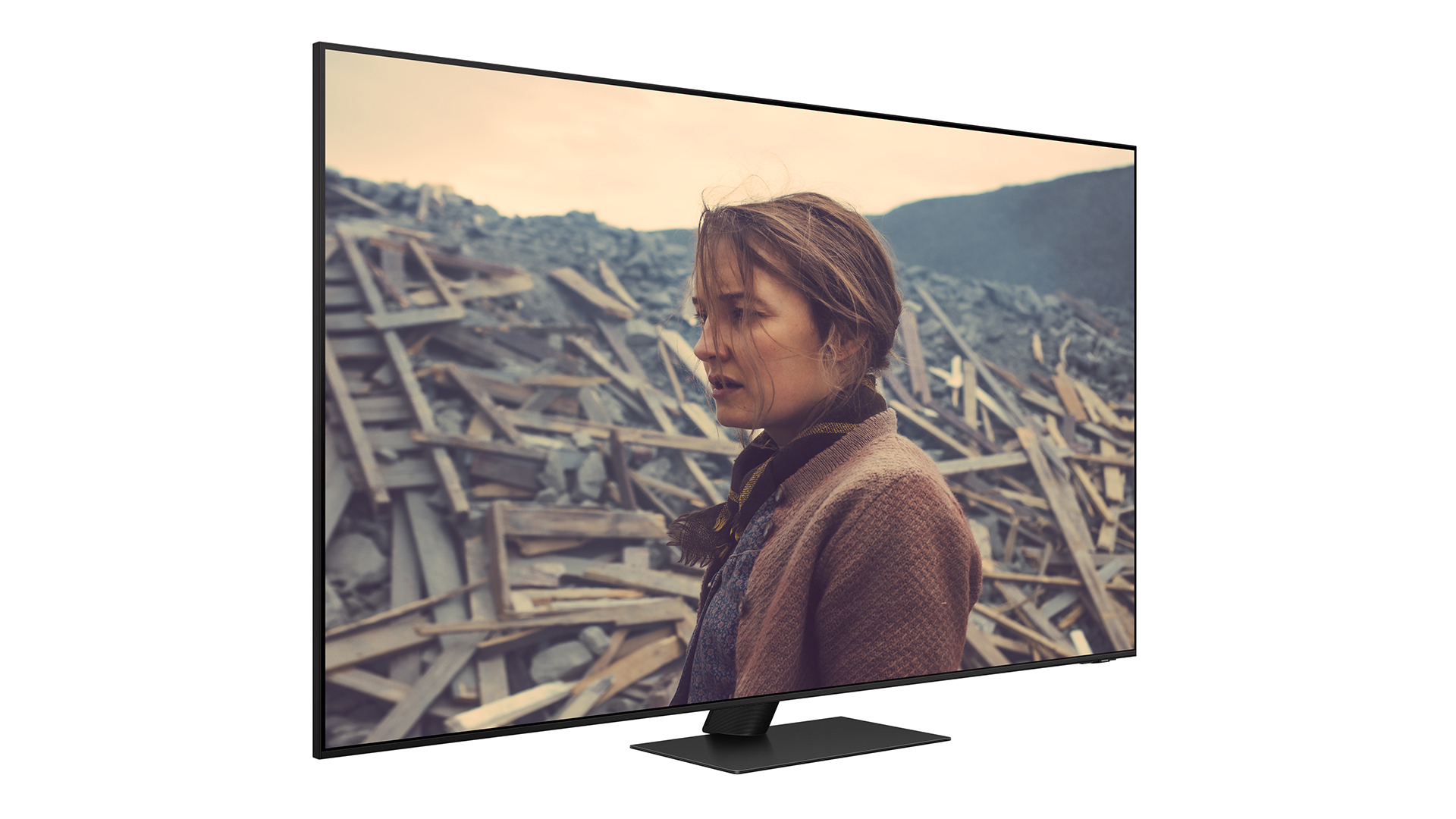
Aside from the cleverness of its Object Tracking Sound system, Samsung hasn’t fared particularly well with the built-in sound systems of most of its recent TVs. The QN95C, though, marks a big step in the right direction.
Particularly pleasing is how much bigger its audio ‘landscape’ sounds. Film mixes are cast much further to the left, right and even above the screen than they have been with other recent Samsung TVs – and there’s enough power behind the sound projection to ensure that the resulting soundstage doesn’t sound brittle or incoherent.
The array of eight mid/bass drivers spread across the QN95C’s rear don’t succumb to distracting buzzing or chuffing with even quite extreme movie soundtracks, while at the other end of the spectrum harsh or shrill details have enough headroom to avoid sounding wishy-washy or harsh.
The speakers manage to pick out even quite subtle sound mix details without exaggerating their weight, too – a talent that joins forces with the improved projection and Samsung’s latest OTS speaker arrangement and processing to place effects both on and around the screen with convincing accuracy.
In a perfect world bass would reach a little deeper, the sound would express more forward into the room, and the volume and dynamics would be able to keep expanding to fully match the most extreme soundtrack moments, rather than ‘topping out’ a few volume points early. In the context of real rather than 'fantasy TV sound', though, the QN95C’s sound can be considered good.
Verdict
After only achieving a relatively mild improvement over their predecessors with its 2022 Mini LED TVs, Samsung has moved things on much more convincingly with the QN95C. Nearly doubling the number of dimming zones has elevated almost every aspect of picture quality, aided and abetted by an also much-improved video processing system. The spectacular new pictures are partnered, too, by far more immersive and impactful new sound.
A few presets require a bit of tinkering, but provided you can live with that (and surely you can), the dazzling but also newly refined QN95C is very much the LCD TV world’s new benchmark.
SCORES
- Picture 5
- Sound 4
- Features 5
MORE:
Read our review of the LG OLED65G3
Also consider the Sony XR-65A95K
Read our Panasonic TX-65LZ2000 review
What Hi-Fi?, founded in 1976, is the world's leading independent guide to buying and owning hi-fi and home entertainment products. Our comprehensive tests help you buy the very best for your money, with our advice sections giving you step-by-step information on how to get even more from your music and movies. Everything is tested by our dedicated team of in-house reviewers in our custom-built test rooms in London, Reading and Bath. Our coveted five-star rating and Awards are recognised all over the world as the ultimate seal of approval, so you can buy with absolute confidence.

